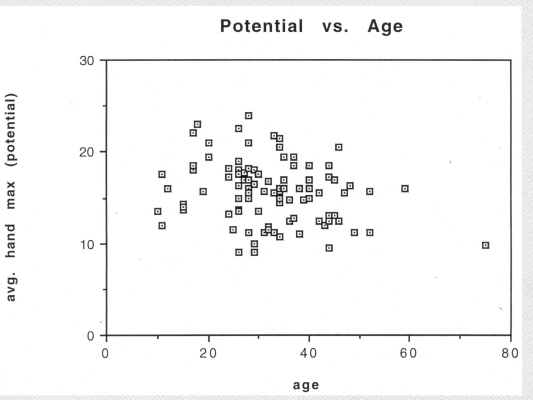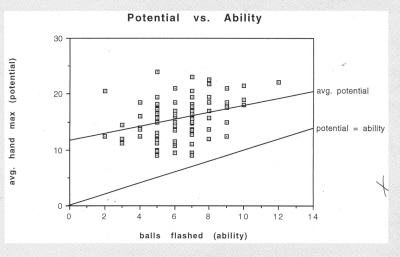
|
 |
 |
Page 43 Winter '97 - Spring '98
|
Each juggler I tested repeated the calibration test with an amount of balls that they could juggle comfortably, to convince themselves that the meter calibration was fairly accurate. Some people were unable to simulate the proper hand motion without actually juggling the balls. On the other hand, many were able to reproduce the proper hand motion, and after pretending to juggle 5 balls, were shocked to see the meter reading "5". "How does it know?!!"
To find the maximum potential of each subject, I told them to shake the jugglemeter as hard and fast as they could, for a few seconds, in an up-and-down motion. (This was the most interesting part for spectators.) I measured the maximum with each hand and allowed one retry if they thought they could do better.
Summary of Test Results I tested over 100 people rang- ranging from non-jugglers to some of g the best jugglers in the world. Every one of the test subjects had the hand speed to juggle 9 balls. The average was about 16 balls, and the highest recorded was about 24 balls. Hand speed did tend to increase slightly with juggling ability. Those who said they had flashed 9 or more balls averaged about 18.3, while those who had never flashed 5 balls averaged about 14.4.
Comparing subjects with comparable juggling ability: hand speed averaged highest for people around 18 years old; there was a small decrease in hand speed with age; and males tended to get slightly higher readings than females.
Often there was a difference between the two hands and many were surprised to find they did better with their "bad" hand. I suspect that some of the test subjects were not trying as hard as they could have. Also I suspect some could have done better by relaxing their arms more - it helped me.
Conclusions Every person I tested demonstrated the hand acceleration needed to juggle a smooth 9 ball cascade. Unfortunately, catching wild throws in a messy, inaccurate 9 ball cascade requires much more acceleration than this. And very few of the test subjects have the accuracy to juggle 9 balls smoothly.
By practicing, one's accuracy improves, the demands on one's acceleration are lessened, and the juggling actually requires less and less effort. It requires much less effort to juggle 7 balls well than to juggle 7 balls badly.
Here are some illustrations of how inaccuracy leads to higher acceleration. If one makes a throw too far across and has to move the catching hand twice the usual horizontal distance in the same amount of time, this requires twice as much horizontal acceleration. If so one's inaccuracy is in throw height, there is an even more unfortunate relationship. Suppose one hand makes a slightly high throw followed by a slightly low throw, so that the two balls come down at almost the same time. If a throw has to be made in half the normal time, this requires four times the vertical acceleration. If juggling 7 balls, this correction would probably be beyond human capabilities.
I believe that eventually someone will juggle 13 balls, and flashing 15 doesn't seem too unlikely. But how can anyone get to juggling 13 balls smoothly without wasting many years trying to juggle 13 balls badly? It will probably require new training techniques, for example a technique that so allows the juggler to practice throwing balls accurately at 15 ball juggling speed, without worrying about catching them and picking them up every few seconds. But that's another paper. |

|
 |
 |